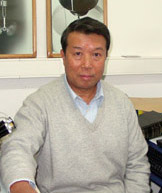|
内容是有关果蝇学习.其中蘑菇体的作用是最重要的. 主要工作是他的博士后郭建增完成.其工作曾经在去年六月的GORDON会议上被评为五佳之一. 附录: Principal Investigator Aike Guo, Ph.D. Prof. Aike Guo is the Associate Director of ION and a Senior Investigator and Head of the Laboratory of Learning and Memory. He also serves as the Principal Scientist for the ION Program Project "Brain Development and Plastisity" sponsored by the Ministry of Science and Technology of China (2000-2005). He became an academician of the Chinese Academy of Sciences in 2003. Dr. Guo's current research interest is to understand the molecular, cellular, and integrative mechanisms underlying learning, memory and cognition-like behaviour,e.g., decision-making and selective attention in Drosophila. Guest Investigator: Chun-Fang Wu, University of Iowa Staff & Students:click here Research Interests Other Research Projects. Besides studying the choice behavior, we are also interested in the neural mechanisms underlying selective visual attention in Drosophila, and in the role of circadian rhythm in modulating the learning and short-term memory in¡¡ Drosophila. We are also studying the role of Drosophila amyloid precursor-like protein in regulating the neuronal morphology and function, with an aim to identifiy molecular and cellular basis of cognitive disfunctions. We are also developing a behavior paradigm for studying nociception-like behavior in Drosophila. For studies at the molecular, cellular and circuit levels, a combination of genetic approaches, e.g., GAL4-UAS expression and dsRNA disruption, electrophysiological recording, and calcium imaging are used. A variety of behavior paradigms, e.g., visual operant conditioning and odor-aversion learning, are used to identify behavior alterations that are amenable for further dissection by molecular and cellular approaches.
Tang, S., and Guo, A. (2001) Choice behavior of Drosophila facing contradictory visual cues. Science, 294: 1543-1547 Wu, Z., Gong, Z., Feng, C., and Guo, A. (2000) An emergent mechanism of selective visual attention in Drosophila. Biol.Cybern., 82(1): 61-68 Yu, D., Feng, C., and Guo A. (1999) Altered Outward K Currents in Drosophila Larval Neurons of memory Mutants rutabaga and amnesiac. J. Neurobio., 40(2): 158-171 Xia, S., Feng, C., and Guo, A. (1999) Temporary amnesia induced by cold-anasthesia and hypoxia in Drosophila. Physiology & Behavior, 65/4-5: P617-623 Xia, S., Feng, C., and Guo, A. (1998) Multiple-phase model of memory consolidation confirmed by behavioral and pharmacological analyses of operant conditioning in Drosophila. Pharmacology Biochemistry and Behavior, 60(4): 809-816 Liu, L., Wang, X., Xia, S., Feng, C., and Guo, A. (1998) Conditioned Visual flight Orientation in Drosophila melanogaster Abolished by Benzaldehyde. Pharmacology Biochemistry and Behavior, 60(4): 809-816 Guo, A., and Goetz, K.(1997) Association of visual objects and olfactory cues in Drosophila. Learning & Memory, 4(2): 192-205 Xia, S., Liu, L., Feng,C., and Guo, A. (1997) Memory condolidation in Drosophila operant visual lerning. Learning & Memory, 4(2): 205-219 Xia, S., Liu, L., Feng,C., and Guo A. (1997) Drug disruption of Short-term memory in Drosophila melanogaster. Pharmacol, Biochemi. & Behav., 58(3): 727-735 Guo, A., Liu, L., Xia, S., Feng, C., Wolf, R., and Heisenberg, M (1996) Conditioned visual flight orientation in Drosophila : Dependence on Age, Practices and Diet. Learning & Memory., 3: 49-59 |
神经所郭爱克组又一篇关于果蝇学习的文章被Science接受
时间:2005-04-28 18:12来源:ION 作者:bioguider 点击:
2198次
顶一下
(26)
100%
踩一下
(0)
0%
------分隔线----------------------------
- 发表评论
-
- 最新评论 进入详细评论页>>
- 推荐内容
-
- 理解大脑神经环路发育过程:Holl
Hollis Cline博士,多里斯神经科学中心,TSRI多里斯神经科学中心,...
- 肖百龙解读诺贝尔奖:Piezo的发现故
要充分信任自己的学生、博士后,给予他们充分的时间和环境去...
- 专访湖南师大李国林博士:间歇性
这是一篇论文,也是一位中国科学家在美国NCI做访问学者1年2个...
- 专访生物黑客Patrick Paumen:当我在体
你有没有想过这样一个场景,你的家门钥匙、门禁卡、车钥匙、...
- 专访戴俊彪:合成基因中国何以效
用化学物质合成生命,人类正一寸寸向“造物主”的角色挪近。...
- 专访嘉和生物CEO周新华:安进到嘉
目前,单抗药物已成为全球生物医药技术市场上利润最高的品种...
- 理解大脑神经环路发育过程:Holl

